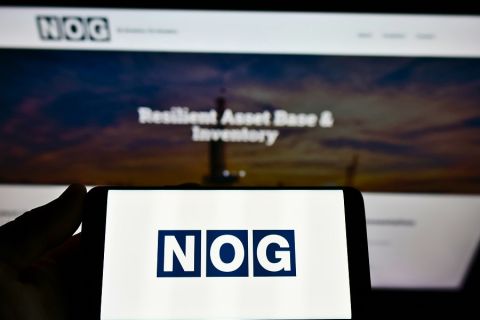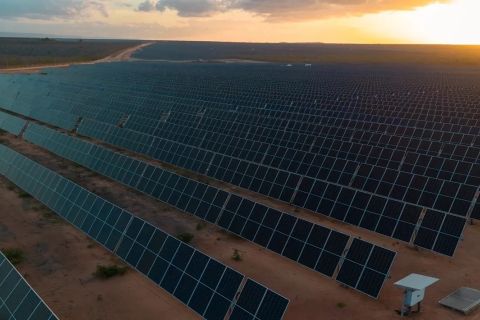During the last 18 months, the mixed signals that have frustrated companies, their lenders and the deal pace could best be symbolized by the two-faced theatrical mask that smiles and frowns simultaneously. This should be a heady time. For more than a year now, unusually high oil and gas prices have translated into 15-year-high rig counts. But outstanding production, earnings growth and cash flows have not turned many heads on Wall Street. No one seems to believe oil prices are real. "It's an interesting paradigm-for the first time in the last 10 years this industry is making money, and everybody is complaining about it," only half-jokingly says Mark Ammerman, managing director of U.S. energy M&A for Scotia Capital. In June when natural gas prices fell off their unsustainable (and politically incorrect) perch, the skeptics crowed, We told you so. Worse, momentum investors fled the sector while analysts downgraded exploration and production stocks. But on a more positive note, conventional wisdom predicts that these "more realistic" gas prices may cause a flood of deal-making in the second half of 2001. "I am bullish on gas, but E&P companies have been conservative. Everybody is out pitching deals now, but few [bankers] have been given assignments," says one investment banker. "There are a lot of itchy fingers out there, now that gas prices have come down some." "Capital markets are still pretty restrained and private equity is tight, with the exception of energy and power," notes D. Martin (Marty) Phillips, cofounder and principal with EnCap Investments LLC. Meanwhile, trends in the oil and gas sector remain mixed. In the first half of 2001, E&P companies enjoyed their best cash flows ever. Global Marine's SCORE, or Summary of Current Offshore Rig Economics, rose in May for the 21st consecutive month, pushing dayrates up to levels not seen in two years. But now, reports floating through the industry indicate some operators have pulled back because they are not comfortable with these increased drilling costs. Lower gas prices have rendered formerly good projects marginal again. "The banks never loaned on $10 gas anyway, so the drop in gas prices doesn't change things too much," says Tim Murray, Wells Fargo Bank energy group manager and president of Wells Fargo Energy Capital. "We are hopeful that A&D activity will soon pick up." Notes John Thompson, vice president and comanager of Enron Energy Capital Resources: "People are somewhat concerned about gas prices, but if you compare $3 or $4 to long-term historical trends, it's good. The strip price does affect the amount we can pay for reserves in a production payment, but gas prices and interest rates both are falling, so one offsets the other in terms of impairment of value." An M&A storm? Oddly enough, strong E&P cash flows have been a mixed blessing for the financial community, as they have put a lid on acquisition activity and much of the financing that accompanies it. Disciplined buyers have waited out the market. Devon Energy Corp., for example, announced a $1-billion stock buyback program rather than using that free cash flow to buy at an apparent market top. "Good times are a two-edged sword," says Chip Webster, managing director and executive vice president of the new Duke Capital Partners LLC. "Sometimes with higher prices, there's gridlock in terms of acquisitions, and high cash flows result in less requirements for capital. But assuming we're in a new price paradigm, development projects are now economic and will need to be financed." Most people now define the first half of 2001 as the calm before the storm. Two-year-old pooling restrictions against selling properties from newly merged companies expire this fall, so noncore assets from BP, Exxon Mobil and other recent megamergers should start hitting the market. The financial community stands ready. "Two of the mantras we hear today are that every acquisition has to be accretive to earnings and cash flow from day one, and it's got to be neutral to the debt-to-equity ratio," says Ammerman. "Nobody wants to do an equity deal now because they think their equity is undervalued." In the past year Scotia has been involved in some of the largest North American gas mergers. Among other deals, it advised Numac in its C$900-million sale to Anderson Exploration, Calpine in its C$1.2-billion buy of Encal, and Berkley Petroleum in its defense against Hunt Oil and ultimate sale to Anadarko Petroleum. "You've got to show a Canadian seller that he is exposed to both Canadian and U.S. buyers. On the Berkley deal, in a day and a half we contacted about 20 business-development people and we got the first six or seven that were really interested into the dataroom as soon as possible. "It's been a real shopping spree. We've seen everyone in the datarooms from the smallest U.S. producers to the likes of Apache and Calpine." Sellers know that this year, natural gas reserves in the U.S. and Canada can be sold for prices well above the five-year average. Lehman Brothers' Jeffrey Robertson calculates that, based on six recent gas-rich company acquisitions (including that of Williams buying Barrett Resources), the implied purchase price of gas reserves has been $1.51 per thousand cubic feet equivalent. This compares to the average enterprise value of 14 midsize independents of $1.36 per Mcfe, implying more M&A activity to come. The private capital providers are no less eager to implement an exit strategy these days. A fine exit There may not be a more dramatic example of a well-timed exit than Houston-based Sierra Minerals Inc. Earlier this year before gas prices fell, it sold Alvarado gas field in South Texas for $123 million-a property it bought five years earlier for just $1.9 million. The buyer was utility People's Energy, which in the past year has kicked off its new E&P subsidiary in Houston. "The field had outstripped our small staff, yet we had identified another 40 locations," says John Eads, Sierra cofounder and principal. "People's has a lot of capital to put into it. We retained a 50% working interest in about 4,000 acres and will jointly develop that portion with them." Privately held Sierra's game plan is simple: buy very specific producing properties that have upside potential, expand production and cut costs to improve value, then sell. It has made about 40 such acquisitions during the past six years. All were set up as partnerships and all but one or two of them were funded by EnCap Investments LLC, the sole limited partner. When the deal closed in April, gas prices were about $5 per Mcf. In addition to its required payout, EnCap Fund I received a substantial amount from the equity kicker associated with the original financing. In 1996, when Sierra acquired Alvarado Field in Starr and Hidalgo counties, Texas, there were 13 wells on about 2,000 acres. Production was about 2 million cubic feet per day. After conducting a regional study and deepening a well to the Lower Vicksburg to test its theory, Sierra got busy, leasing 9,000 contiguous acres. It shot 3-D seismic, then completed 21 wells in a row, each flowing 3- to 4 million cubic feet per day. The wells cost about $1.3 million each to complete. EnCap funded everything through a partnership where the latter was the sole limited partner; Sierra is the general partner. Sierra in turn formed a partnership with a private company in Alice, Texas, whose job it was to drill and operate the wells. Sierra provided technical expertise, some prospect generation and the ability to add more properties to the partnership, and it brought in capital through its relationship with EnCap. At press time, EnCap had begun its road show to raise Fund 10, a private equity fund, from institutional investors. Its new parent company, El Paso Corp., will take up 20%. "It's kind of our 'anchor tenant,'" says EnCap principal Robert Zorich. EnCap is aiming for at least $500 million this time, but the partners admit they hope for $750 million. All its current funds have been committed, with just enough left over to do follow-on deals with its existing portfolio of private capital recipients. "This will be our 10th fund. We are targeting a 30% rate of return for it," says principal Gary Peterson. "Our average pretax rate of return has been about 23%. All of the first seven funds have reached their targeted return objective, which of course varies depending on whether it is a mezzanine or private equity fund." By preselling the fund to existing Encap investors who will participate again, the partners have reason for optimism. "Energy markets were not attractive to investors two years ago, but today they are," says Zorich. Adds partner David Miller, "Then, they were not interested in a 20% return in energy when they could get five or 10 times their money in high-tech." Since its formation in 1988, EnCap has invested an aggregate $759 million in 44 transactions. In time, it has become more a provider of corporate start-up and growth equity capital, as opposed to project finance, although it still does the latter. It tries to contribute by making an impact on a client's evaluation process, strategy and capital markets approach, as well as formulating exit strategies, says Miller. In the past three years it has backed 17 companies in its portfolio, all managed by people it calls "proven value creators." These firms are in the start-up, growth or restructuring phase. Matrix Oil & Gas in Covington, Louisiana, is an example. The company was started 10 years ago, focused exclusively on the shallow-water Gulf of Mexico. "We've done several project financings (three deals totaling $28.6 million) for them for acquisitions. They have a highly operational and technology-intensive team, which we like," says Phillips. "About a year and a half ago we made a new investment in Matrix by rolling all its partnerships into a new entity, which gives them more flexibility. They have more than doubled their production rate in the last nine months." Fickle capital markets Late last year and earlier this year, the public capital markets have been fairly slow. Energy-related initial public offerings led the market, accounting for a third of all U.S. IPO proceeds through June, according to an IPO.com quarterly report. Since January, several large debt deals have closed successfully. Transocean Sedco Forex and Anadarko Petroleum each placed $1.3 billion of private debt. Other private placements included the $800-million note offering of Chesapeake Energy Corp. and the $800-million zero-coupon convertible bonds offered by El Paso Corp. Yet in June and July two IPOs were withdrawn, that of Midland well servicing firm Basic Energy Services Inc., and that of American Eagle Tankers Inc., a Jersey City, New Jersey, transporter of crude oil to the U.S. In such a market, some secondary offerings also suffered. In May, Callon Petroleum Co. withdrew its planned $225-million private issue of senior notes, which in turn was a trigger for a public stock offering that also had to be killed. The Natchez, Mississippi, company found the coupon of more than 12% not to its liking. But just seven weeks later, Duke Capital Partners LLC, a new player in town, rode to the rescue in the form of a $95-million multiple advance term loan. The deal gives Callon some fresh cash-and gives Duke an overriding royalty interest equal to 2% of Callon's net interest in four deepwater discoveries. Production is scheduled to begin in 2002, at which time Callon's cash flow is expected to rise significantly. Callon issued to Duke $45 million of 12% senior notes and will issue the remaining $50 million of such notes before June 30, 2002. It also issued warrants to buy 265,210 shares of common stock, trading at about $11 per share at the time this deal was announced. Duke's new finance unit is headed by Amiel David and F.T. (Chip) Webster, both managing directors. Webster and most other members of the team came from the old First City Bank and Bank of America in Houston; they have been in energy finance for 30-plus years. Amiel, who manages the engineering end, was formerly with First Union Securities. The group provides debt and equity capital to oil and gas and independent power producers, with an emphasis on any business that may be involved with any of Duke's subsidiaries, although this is not a prerequisite, Webster says. Although backed by the considerable capital of its multibillion-dollar utility parent, Duke Capital Partners will actively consider partnering with other capital providers in order to facilitate larger deals. It is also interested in funding start-up companies with established teams. "We've been building our team during the past couple of months," Webster says. "We intend to judiciously invest approximately $1 billion during the next two or three years, with 50% of that in oil and gas, the rest for independent power producers (IPPs)." About 60% of the deals will involve mezzanine finance, including convertible preferred stock. The favored deal size is $25 million, "although we'll target $10- to $50 million, and we can make exceptions on either end of that range," Webster says. Duke Capital will look at senior stretch loans that advance more money on reserves than a traditional bank might do. "Our price deck is somewhat more aggressive, as we ascribe value to the proved undeveloped reserves (PUDs) and thus, we will take some development risk. It all depends on the quality of management and the reserves." As of the end of July, the company had committed about $150 million to independent producers. It assigns a risk grade to each deal, similar to what Moody's or S&P does, and prices the deal accordingly. "We have no stringent guidelines on structure. In some cases we may do a senior loan with one interest rate and a mezzanine component with another, and include equity as well." Bank's new faces Given the recent spate of megamergers between the largest U.S. energy banks, small and medium-size producers complain that it is difficult to get a bank's undivided attention. Some claim their performing loans get shuffled into the workout area of a big bank, or shuffled to New York, when they would prefer local account management. Other E&P firms say that banks' lending parameters have tightened considerably. Fortunately, the Houston banking scene constantly provides new sources and names. In March, Guaranty Bank, a federally chartered savings and loan based in Dallas and Austin, opened its new Houston energy office and hired long-time banker Arthur (Buzz) Gralla to head the team. Guaranty, with $15 billion in assets, is owned by Temple-Inland, a NYSE-listed company. It bears the distinction of being one of the largest locally owned financial institutions in Texas. During the last decade it has quietly transformed itself from a pure savings bank to a full-fledged commercial bank, and now it has added the oil and gas piece to its portfolio. Gralla brings more than 25 years with Bank One and its predecessors in a similar role. Joining him is Frank Dartez, manager of engineering, also formerly with Bank One. The pair has worked together since 1979. "We are aiming for the small and midsize independent who needs loans in the range of $5- to $50 million.[We'll syndicate it if any larger.] This niche is a good one for banks with the appropriate staff experience," says Gralla. "We have the ability to grow with these companies. We are not going to be just fair-weather friends. After all the ups and downs we've seen during the years, one thing we believe is that experienced bankers who can support their clients in tough times are in relatively short supply. Most anyone can get into energy banking when times are rosy." Guaranty Bank will consider E&P start-ups. Most of the companies it will fund will probably be private, Gralla says; all may need financing for development drilling or debt repayment, notwithstanding very high cash flows. Some may have been "turned off" by the larger banks and their many changes, so they seek some continuity and the attention a smaller bank can provide. "It's true that banks are looking harder at their profits and rate of return these days," notes Dartez, "and in some cases they've raised their benchmarks, but that is more an issue at the largest banks. They want loans to syndicate on down the line, whereas we have strong liquidity here and want to retain those [energy loan] assets on our books. We aren't after investment banking business too; this is all we do." Comerica Bank-Texas, active in energy lending since 1993, recently reorganized by assembling what it calls the "the energy SWAT team" in Houston. Gary Orr remains president of the Houston region, but this summer, Charles E. Hall came on board as senior vice president and group manager for energy, joining senior vice president for business development Dan Steele. "We want to understand and finance ideas as much as the underlying assets," says Orr. "And, we have redoubled our efforts. Where we previously focused only on E&P, we now are adding midstream clients and offering volumetric production payments, and we have expanded to Canada, with Calgary the focal point." "Cash flows are particularly strong now and there has been some delevering...but this industry just chews through capital," says Hall, who previously worked for Chase and Den Norske Bank. Most recently he administered the federal emergency oil and gas loan program from Washington, D.C. "There is a tremendous need to drill and put in more infrastructure. The last 18 months may have been slow for banks in general, but we are very comfortable that that will change. Everything ebbs and flows" Comerica reviews its price deck once per quarter, although it still considers management the real key to decisions. It target its loans from $5- to $25 million although it has the capacity to underwrite larger deals, as the originator or in a bank syndication. Like all banks, it hopes to follow a small-cap producer from the growth stage to successful exit rather than just doing one-time deals. For Texoil Inc., it had a $5-million facility some years ago, which grew to about $50 million. In time, that company grew and was just sold to <$iOcean Energy > for more than $100 million. "We saw it from infancy to maturity and now, we will bank Frank Lodzinski (the principal of Texoil) again as he starts building his new company," says Steele. "A lot of private, small-cap independents have sold over the past two years, but those are the guys who will be out there buying properties again, and we will be there to jump in with them," Hall says. The bank also works with financial restructurings, as evidenced by its long-term relationship with Plains Resources and its spin-off, Plains All American Pipeline. Proved undeveloped reserves are evaluated and may be part of a loan package, but it depends on quality. "There are low-risk PUDs and there are high-risk PUDs," notes Hall. At Bank of Texas, based in Dallas, growth is also a byword. The bank recently expanded by buying several Houston branch banks and opening its new Houston office for energy. Martin (Marty) Wilson is senior vice president and manager of the energy lending effort in Houston. "Energy is not an afterthought here. Our majority owner is Tulsa oilman George Kaiser, who knows energy. He wants an energy bank that can meet the needs of our region, that has not been gobbled up by a bank from outside the region. For so many of the biggest banks, energy is not their core business." Bank of Texas focuses on small and midsized, mostly private, independents and targets loans of at least $3 million. The sweet spot is $5- to $15 million. "It's a home run for us to do a $25-million loan. Past that size, other banks start to participate," says Wilson. "We love to follow a client's growth. We recently loaned $1 million to a company and it quickly grew to $18 million in 18 months. We also made a $700,000 loan that grew to $8 million, and it was not due to oil price appreciation, it came from drill-bit success." Unlike some other banks, Bank of Texas revises its price deck every month based on the 12- and 24-month strips on Nymex. "We have a bit rosier outlook than some banks, and we look out for longer-life properties," says Wilson. "When we start seeing high prices, we rein in our advance rates and when they are low, we start to be more aggressive than other banks. We'll look at PUDs on a case-by-case basis. A PUD in this high-price environment is a lot different than a PUD in a $2-gas environment." All banks seek the ideal of a long-term relationship. In April, Wells Fargo closed on a new $17.75-million senior reducing revolving credit, and at the same time, Wells Fargo Capital closed on a $5-million subordinated advancing line of credit with both facilities, for Canyon Oil & Gas Partners and Willo Oil & Gas Partners, which are affiliated producers based in Bulverde, near San Antonio, Texas. The relationship dates from 1999, when Wells Fargo initially helped Canyon just two days after a meeting-the producer was trying to acquire properties from EEX Corp. that had a closing deadline of five weeks. Wells Fargo was able to move quickly enough to accommodate that tight time frame, says Tim Murray. "Canyon is an example of the kind of company we like to work with, one that is new and growing rapidly," says Murray. "We gave them capital to accelerate their program and keep the rigs they had contracted for-in this climate, if there had been a lull in their drilling, they would have lost the rigs to another job." Flexible creativity Enron Energy Capital Resources has renewed its focus on an array of products including volumetric production payments, a financing structure it pioneered, and indeed dominated, in the 1990s. In the '90s Enron did about $1 billion of VPPs and just since December, it has closed on $300 million more. This year it hopes to provide about $500 million in capital to the oil and gas industry through a variety of structures. Today ECR has close to $1 billion of assets or corporations under management, through project equity or corporate equity, not counting the volumetric production payments. Backed by the heft of Enron Corp., the group can provide the full spectrum of capital: senior debt, secured loans, a variety of mezzanine structures, and corporate and project equity. In select cases it invests equity in drilling partnerships, in the form of nonoperating working interests. Dealing with Enron can also lead to increased deal flow for its E&P partners. For instance, two Houston clients have accessed drilling opportunities from ECR's acreage held in South Louisiana. Its most dramatic financing of late was a $178-million VPP made to KCS Energy Inc. as the latter emerged from bankruptcy earlier this year. In addition, KCS raised $30 million of convertible preferred stock in a private placement arranged by Sanders Morris Harris, Houston. The KCS financing was complicated as it involved the bankruptcy court, was the largest non-affiliated VPP Enron has done, and there were 30 to 40 producing fields involved. The deal was done in just six weeks. ECR prides itself on being fast-paced. For The Woodlands, Texas-based Preston Exploration LLC, it funded a VPP on December 8, 2000, just 10 business days after Preston gave the go-ahead. Preston focuses on deep, high-risk, high-potential onshore gas plays. Ironically, ECR sought its business, rather than the other way around, because Preston has such a good record of finding large reserves. On a very selective basis, ECR prefers to work with just one or two operators in each play or geographic area. In Midland, for example, it has placed a significant, but confidential, amount of seed capital with Westwin Energy, a Permian-Basin-focused acquire-and-exploit company that aims to be a triple-digit market-cap size someday soon. (See "Aiming for Permian Power," Oil and Gas Investor, June 2001). ECR will not capitalize other companies that would compete in the same region. However, it has financed a second Midland company, Crescendo Energy Partners, with $27 million, in a deal that has more of a project-equity tone. Crescendo follows a "low-Btu" strategy. It buys gas properties that aren't yet pipeline quality and need processing to remove the nitrogen. ECR, with its client, is in the process of building a plant in the Piceance Basin to remove the nitrogen on reserves Crescendo has in Utah and Colorado. ECR has come in after the start-up equity was provided by others, to provide second-stage equity for further growth, such as it did in 1996 for Midland-based Titan Resources, now Pure Resources. ECR still owns 95% of Mariner Energy, the Houston independent pursuing deepwater opportunities, and 90% of Midland-based Westwin Energy. "This high level of ownership speaks to our investment philosophy," says Scott Josey, comanager. "We will also do refinancings-it really is about the whole capital supply-demand issue for us, that is, the lack of availability of capital for a client, whether it's in bankruptcy or not," explains comanager John Thompson. "The issue is, what kind of financing or refinancing can we provide?' In addition to capital, ECR offers oil and gas marketing, hedging, outsourcing and back-office functions. And in a new twist, it is funding a technology company whose software can help client companies evaluate bypassed pay opportunities in property-acquisition candidates. For Nutech Energy Alliance, in Kingwood, a Houston suburb, ECR took out the latter's venture capital funding earlier in 2001 and now owns a controlling interest in the company. Nutech has developed a proprietary log interpretation software that simulates a magnetic resonance imaging log on older, traditional logs, thus allowing an operator to find bypassed pays in a new way. "Our strategy is not necessarily to start capitalizing service companies, but to take Nutech's technology, coupled with our capital products, and create new value with our client E&P companies. If someone comes to us for capital, we can also offer them this technology," says Thompson. It's all part of the trend to offer more than one service, and to stay with a client for the long term.
Recommended Reading
Northern Oil and Gas Executes on Ground Game A&D
2024-02-16 - The non-op E&P reported $25 million in “opportunistic” acquisitions in the fourth quarter.
Parker Wellbore, TDE Partner to ‘Revolutionize’ Well Drilling
2024-03-13 - Parker Wellbore and TDE are offering what they call the industry’s first downhole high power, high bandwidth data highway.
Ecopetrol, Occidental Permian JV Generating Positive Results
2024-03-07 - Ecopetrol SA's joint venture with Occidental Petroleum in the Permian continues to generate outstanding operational and financial results for the Colombian state-owned energy giant.
Equinor Brings Solar Plant Online in Brazil
2024-03-08 - Equinor says the Mendubim solar plant will produce 1.2 terawatt hours of power annually.
TotalEnergies, Sinopec to Develop SAF Unit in China
2024-03-26 - TotalEnergies and Sinopec’s production unit will have the capacity to produce 230,000 tons of sustainable aviation fuel per year.





